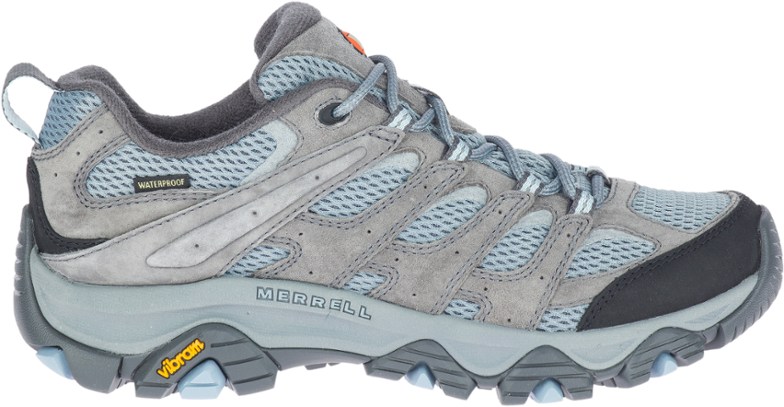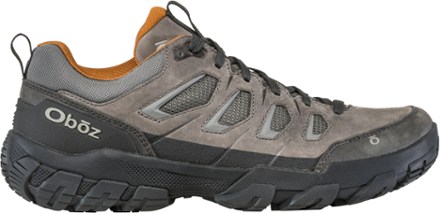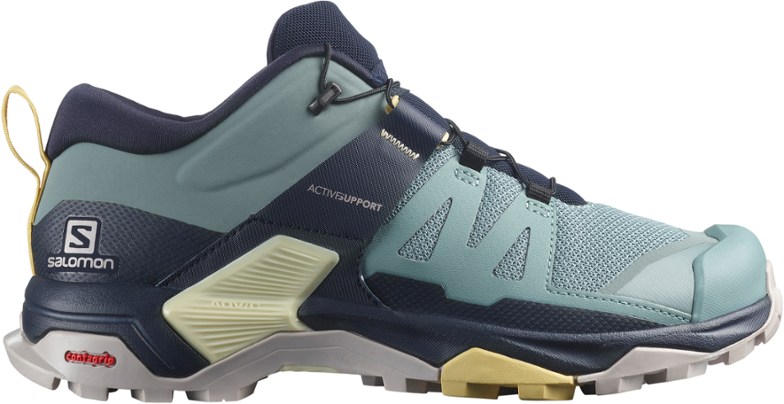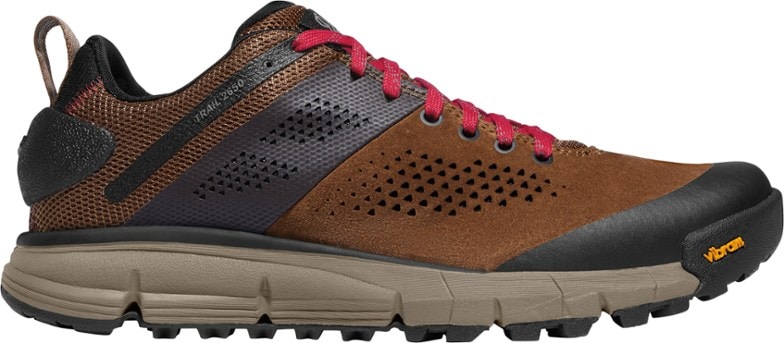
The Best Hiking Shoes for Thru-Hiking in 2025
Think of your hiking shoes as an investment in your future happiness. Choosing the right pair can mean the difference between success and failure on a thru-hike. And, more generally, between a happy hike and a blistery sufferfest. In this post, we’ll share our picks for the best hiking shoes for thru-hiking and backpacking, as well as tips on how to choose your footwear.
READ NEXT – The Best Trail Runners for Thru-Hiking
Best Hiking Shoes for Thru-Hiking: Quick Navigation
Merrell Moab 3 (Popular on the AT)
Keen Targhee II (Best Hiking Shoe for Wide Feet)
Oboz Sawtooth (Best Insole)
Salomon X Ultra 4 Low (Best for Rough/Technical Terrain)
Hoka Anacapa (Most Comfortable Hiking Shoe)
Danner Trail 2650 (Best Lightweight Hiking Shoe)
Best Hiking Shoes FAQs
What’s the Difference Between Hiking Shoes, Boots, and Trail Runners?
Waterproof vs. Non-Waterproof
Hiking Footwear Terminology
After-Market Insoles
Blister Prevention
About This Year’s Picks
Please note that this post covers hiking shoes — a type of footwear partway between a trail runner and a hiking boot (see below for more information on different types of hiking footwear). If you prefer trail runners for thru-hiking, we have a separate post about that. If you prefer full boots, every shoe on the list below also has a mid-boot version to provide more ankle support.
Weights listed below are for a pair of medium-sized shoes (sizes 8 or 9). For consistency’s sake, we featured the non-waterproof version of every hiking shoe in the list below. Waterproof versions are also linked in the descriptions.
The Best Hiking Shoes for Thru-Hiking
Merrell Moab 3 Women’s | Men’s (Most Popular Hiking Shoes on the AT)

Best hiking shoes for thru-hiking: Merrell Moab.
MSRP: $120
Weight: 26 oz women’s | 33 oz men’s
Upper Materials: Pigskin leather and mesh
Waterproof version: Women’s | Men’s
Pros: Vibram soles; made with recycled materials; affordable
Cons: Heavy; not the most durable hiking shoes
Details
The Merrell Moab 3 was released in spring 2022. The newest update features partially recycled materials (the mesh lining, laces, and webbing are all 100 percent recycled. The Moab 3 has also been upgraded to a gripper version of its classic Vibram outsole and a more cushioned midsole.
In our experience, Moabs tend to wear out after 600 or 700 miles, making them barely more durable than a trail runner (though we’ve heard reports of them going much further). Superior durability is one of the main advantages hiking shoes and boots have over ever-popular trail runners, so this is a bit disappointing.
In fairness, the reduced durability could have something to do with the large amount of mesh in the shoe’s upper — and the abundance of mesh is a pro in our books since it improves breathability.
And even with a potentially shorter lifespan, the Moab is still very affordable. The $120 list price is lower than every other hiking shoe on this list, as well as all of our favorite trail runners for thru-hiking).
While hiking shoes are definitely less popular on the AT than trail runners, it’s worth noting that the Moab has been the most popular non-trail runner hiking shoe in our annual AT thru-hiker survey since 2021.
Keen Targhee Women’s | Men’s (Best for Wide Feet)

Best hiking shoes for thru-hiking: Keen Targhee
MSRP: $150
Weight: 29 oz women’s | 36 oz men’s
Upper Materials: Leather
Waterproof version: Women’s | Men’s
Pros: Leather uppers; contains recycled materials; durable and supportive
Cons: Relatively expensive; very heavy
Details
Keen footwear tends to run wide from the heel all the way through the toebox, and the Targhee is no exception. This durable, supportive shoe features a dual-density EVA foam midsole for maximum comfort and stability.
The Targhee IV came out last year. It’s noticeably heavier than its predecessors, which is a bummer, but that extra weight comes with the promise of superior durability. The outsole has been reworked to be more abrasion-resistant, the midsole foam is compression-resistant, and the outsole and upper are fused without using glue, which is more environmentally friendly and should make the shoes less likely to delaminate.
Keen uses leather from a tannery rated by the Leather Working Group, a nonprofit that developed standards for more sustainable leather production. The dark side of a mostly leather upper is that these aren’t the most breathable hiking shoes on the planet.
Keen hasn’t discontinued previous versions of the Targhee even though this new version exists now. The Keen Targhee II (women’s | men’s) is also worth trying if you want a slightly lighter version of this shoe or if the IV doesn’t quite fit right. Unfortunately, the II is only available in waterproof.
Oboz Sawtooth X Low (Women’s | Men’s) (Best Insole)

Best hiking shoes for thru-hiking: Obox Sawtooth.
MSRP: $140
Weight: 27 oz women’s | 32 oz men’s
Upper materials: Oiled nubuck leather and Cordura mesh
Waterproof version: Women’s | Men’s
Pros: Quality insole; recycled materials in laces and webbing
Cons: Longtime users say sizing/fit have changed a lot with the latest version; heavy
Details
Most shoes come with flimsy, terrible inserts that provide no support or protection, hence many hikers swap them out for a $50 aftermarket upgrade to keep their feet happy. Which is a fine solution, but it’s refreshing that Oboz actually bothered to manufacture an insole that’s comfortable from the start. Not having to replace the insert will save you beaucoup bucks, plus it’s one less thing headed straight for the landfill when you buy new shoes. Oboz even sells their O-Fit insoles separately so non-Oboz wearers can get in on the fun.
The Sawtooths are praised for their superior support and stability. They’ve been on the market for over a decade now — hence the X in the name — with no sign that they’re going away any time soon. It’s worth noting that some longtime Oboz users have reported that the newest Sawtooth fits differently throughout.
Salomon X Ultra 4 Low (Women’s | Men’s) (Best Technical Hiking Shoe)

Best hiking shoes for thru-hiking: Salomon X Ultra 4 Low.
MSRP: $140
Weight: 22 ounces women’s| 26 ounces men’s
Upper Materials: Synthetic/textile
Waterproof Version: Women’s | Men’s
Pros: Lightweight; ADV-C chassis improves stability; woman-specific fit
Cons: Quicklace is not for everyone; made with virgin materials; polarizing style
Details
While the Salomon X Ultra’s boxy NASA aesthetic isn’t our cup of tea, it reflects the shoe’s highly engineered, technical nature. Every aspect of this shoe was designed intentionally to optimize foot mobility and support. Even better, the women’s version isn’t just a smaller version of the men’s. It’s a woman-specific design featuring softer materials in some areas and a less dense chassis.
The rubber outsole is very grippy, and the synthetic upper materials are durable and resist wear and tear on rugged trails. The shoe also features Salomon’s ADV-C chassis, a molded insert embedded in the outsole to improve stability and flexibility, and Salomon SensiFit to cradle the foot. The marketing buzzwords are mind-boggling, but they translate to noticeable improvements in function.
Moreover, the Salomon X Ultra is relatively light at 22 ounces for a women’s medium, saving you energy with every step.
Like most Salomon shoes, the X Ultra is a great choice for lazy lacers thanks to its tension-adjustable Quicklace system. (Quicklace is also a great feature if you hate trying to tie your shoes with numb fingers on freezing mornings.) On the flip side, hikers who want to use special lacing techniques will dislike that the lace pulls make this impossible.
If you’re looking for a hiking shoe for casual strolls on groomed trails, this is not your shoe. If you’re heading out on rugged, rocky, uneven terrain, you can’t do better than the X Ultra 4.
Although our annual AT thru-hiker survey is always heavily skewed toward trail runners, this shoe joined the Moab as one of the only true hiking shoes to rank in 2024.
Hoka Anacapa Breeze Low Women’s | Men’s (Most Comfortable Hiking Shoe)

Best hiking shoes for thru-hiking: Hoka Anacapa
MSRP: $155
Weight: 20 ounces women’s | 25 ounces men’s
Upper Materials: partially-recycled polyester engineered knit
Waterproof Version: Women’s | Men’s
Pros: Moderate cushioning; stylin’ colorways; contains recycled materials; Vibram outsoles
Cons: Fit a bit narrower than typical Hokas, particularly in the toebox
Details
Everything about the Anacapa, from the plush EVA foam midsole to the padded, gusseted tongue (designed to keep debris out of the shoe), is crafted with comfort in mind. The insole is made with 50 percent recycled soybean oil and is supposed to be molded for comfort (though you might still want to consider upgrading to a more robust aftermarket insole).
Many think of plush, maximal cushioning when they think of Hokas. However, the Anacapa features balanced, moderate cushioning that trends closer to firm. It strikes an excellent balance between comfort and responsiveness. At 20 ounces for a women’s medium and 25 for the men’s, it’s one of the lightest shoes on this list.
We also give the Anacapa style points for looking more like a normal sneaker and less like a hiking shoe compared to other models on this list.
Danner Trail 2650 Women’s | Men’s (Best Lightweight Hiking Shoe)

Best hiking shoes for thru-hiking: Danner Trail 2650.
MSRP: $170
Weight: 18 ounces women’s | 24 ounces men’s
Upper Materials: Suede leather/textile
Waterproof Version: Women’s | Men’s
Pros: Grippy Vibram sole; style points; lightweight
Cons: Expensive; not very breathable; narrow toebox; made with virgin materials
Details
Most of us picture Cheryl Strayed’s iconic brown leather boots with red laces from Wild when we think of Danner hiking shoes. But although Danner’s Trail 2650 shoe was named for the number of miles on the PCT, they don’t have much in common with the boot Strayed famously threw off a cliff in frustration partway through her LASH (although they do have the classic brown/red colorway).
Like the Merrell Moab above, the Trail 2650 is a great choice for hikers with narrow feet. It’s also a remarkably lightweight option: a pair of women’s mediums weighs just 18 ounces (or 24 for men’s), which puts this shoe on par with many popular trail runners weight-wise.
In addition to the weight savings and style points, we love the Trail 2650’s choice of a grippy Vibram outsole. On a less positive note, the shoe doesn’t offer as much ankle support as some of the beefier options on this list.
With reduced support, one wonders if breathable mesh trail runners would be a smarter choice than these relatively stuffy suede numbers. But wait, Danner has thought of that too! The Trail 2650 is also available in a version with mesh uppers (women’s | men’s). Can we say SoCal desert?
Best Hiking Shoes for Thru-Hiking: FAQs
What’s the difference between hiking shoes, boots, and trail runners?
Trail runners are running shoes specifically designed for rugged trails rather than pavement. They look like sneakers and are the lightest, most breathable, but least durable or supportive type of hiking footwear. Trail runners are the most popular footwear choice among thru-hikers; we have an entire post about the best trail runners for thru-hiking.
Hiking boots are what most people picture when they think of footwear for the trails. They have high-rise ankle support and are stiffer/more durable overall. They weigh a lot more than trail runners and don’t breathe as well, but a pair of boots will last much longer and provide better support for your foot. A boot’s stiffer sole is also a better tool for kicking steps in hardened snow
Hiking shoes are a compromise between trail runners and boots. Many hiking shoes are just low-top versions of popular hiking boots, like the Merrell Moab. Hiking shoes may also use materials that fall between boots and trail runners in terms of breathability and durability. If you want a little more support and durability than trail runners offer but without the crushing weight penalty of boots, hiking shoes are worth a try.
Waterproof vs. Non-Waterproof
Many retailers push waterproof hiking shoes pretty hard, but we recommend the non-waterproof version in most cases. The trouble with waterproof footwear is that it’s just as good at trapping moisture inside as keeping it out. When the inside of your shoe inevitably gets wet, whether due to foot sweat or snow/rain finding its way in through the top, it will take much longer for a waterproof shoe to dry out than a ventilated one. By the same token, they also trap heat.
We do recommend waterproof footwear for early-season hikes where you expect to encounter snow. Not only will your shoes keep you warmer if they’re waterproof, but they will help to keep snow from infiltrating, especially if you wear long pants or gaiters over the top to keep it from getting in the top. You might also want high-top boots for four-season hikes for the same reason.
For consistency’s sake, we featured the non-waterproof version of every hiking shoe in the list above when available. Waterproof versions are also linked in the descriptions.
Hiking Footwear Terminology
It’s useful to understand common shoe-related vocab when comparing shoes. Here are some terms you’ll come across frequently.
Upper: The “main body” of the shoe/the flexible material above the midsole. Usually made of durable mesh or leather.
Insole: A removable footbed insert located inside the shoe that provides cushioning to your foot. Many hikers upgrade to aftermarket insoles like Superfeet that offer better and more targeted support than the factory version. Also called a sockliner.
Midsole: The rubber bit between the insole and the outsole.
Outsole: The grippy rubber bottom of your shoe where all the tread is located.
Rock plate: A nylon shank found in the midsole of some trail runners to protect your sole from sharp rocks. Most common in trail runners.
Heel-to-toe drop: The height differential between the shoe’s heel and toe, normally measured in millimeters. The heel is elevated higher than the toe in most shoes so that the toe points slightly down, but some minimalist shoes have zero drop (no height difference between the heel and toe).
After-Market Insoles
Many hikers swap out the flimsy insoles that come standard with most hiking footwear for a beefier, more supportive after-market offering. Superfeet, available at REI and most other outfitters, are especially popular. If you go this route, swap out your Superfeet every time you replace your shoes to maximize the benefit.
Yes, they’re expensive, but you won’t be able to finish your thru-hike if you ruin your feet, so this is an area worth investing a little extra. If you still struggle with foot pain, it might be worth visiting a podiatrist and getting custom orthotics that are molded to your unique foot shape.
Blister Prevention
Finding a shoe that fits your foot perfectly (and finding the correct size of that shoe) is probably the most important step you can take toward blister prevention. Everyone’s foot is different, and there’s no one-size-fits-all approach to this problem: you just have to figure it out through trial and error.
If you’ll be thru-hiking, bear in mind also that your shoe size may increase over the course of your hike. Because you can’t predict whether and to what extent your shoe size will change, we recommend starting with a pair of shoes that fits your feet now rather than starting a size too big in anticipation of a change that may or may not happen. The start of a thru-hike is challenging enough without adding the difficulty of too-big shoes.
Other methods include:
- Cover potential hotspots with Leukotape as soon as you feel them.
- Slather on some Vaseline to reduce friction.
- Wear a thin, protective pair of liner socks under your primary socks. Opt for toe socks for maximum protection.
- Use the heel lock lacing method to keep your feet from sliding around in your shoes.
More of the Best Thru-Hiking Gear of the Year
Why should you trust us?
Because we’re so incredibly intelligent, of course! Attractive, too. (Not to mention extremely humble).
But if that isn’t enough to impress you, there’s also the fact that everyone who contributed to this article is an experienced thru-hiker with thousands of on-trail miles under their belt. We’re gear nerds who love putting our equipment to the test on trails long and short, and we’ve tested dozens of shoes in pursuit of a smoother, more comfortable hike.
Moreover, we survey hundreds of Appalachian Trail thru-hikers every year to learn about their behaviors, demographics, and — you guessed it — gear preferences. That means our picks for the best hiking shoes for thru-hiking aren’t just our opinions; they’re based on years of feedback from the thru-hiking community.
Check out AT hikers’ favorite footwear from the 2022, 2023, and 2024 thru-hiker surveys.

This website contains affiliate links, which means The Trek may receive a percentage of any product or service you purchase using the links in the articles or advertisements. The buyer pays the same price as they would otherwise, and your purchase helps to support The Trek's ongoing goal to serve you quality backpacking advice and information. Thanks for your support!
To learn more, please visit the About This Site page.

 ">
">



Comments 7
I need a best hiking shoes and low price
Great article. Unfortunately for me, I have large feet, size 12 4E. The more I hiked the wider my feet got. None of the shoes reviewed would even come close to fitting me. New Balance used to be good but 10 years ago they changed and now Hitchcock Shoes are the only ones I know of that will fit.
I love Green Superfeet. I had Plantar fascitis and they made the pain go away. Love them.
If anyone has suggestions for other shoes please let me know.
Fellow size 12, 4E here. The Keen or Merrell mentioned above both come in a wide version and will both fit pretty well. The issue with both of those is a hefty amount of heel-toe drop, which was bad on my knees. Switched to Altra Lone Peak 12-wides and it is the widest shoe I have ever owned, almost comically so (think clown shoes). Very comfortable. Not going back to the heavier hiking shoes anytime soon.
Good luck!
Thanks for the reply. I forgot to mention Propet shoes. They fit great. I do have a pair of trail runners from Propet but I keep banging my ankles and do not like them. I will try some Altras,
The main advantage for me with Moabs over trail runners is … stability … not durability. The durability issue with Moabs seems to be a bit of selective reporting since you do not mention how this compares to the other hiking shoes in the article. I suspect any type of shoe…is going to last roughly 500-600 miles on trail as far as comfort, support, and cushioning. I am a section hiking and tend to replace my Moabs every year after about 500 miles, including day hiking with sections of AT. I used to only get about 300 miles from a pair of running shoes during my marathoning years. All shoes wear out with daily rough use and expecting them to get more than that from trail shoes on a trail is wishful thinking. I repurpose mine into yard/work shoes because they still have a lot of durbility left, but very little stability or cushioning for rough use.